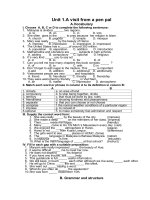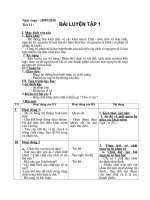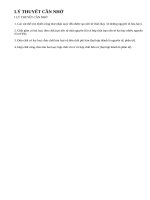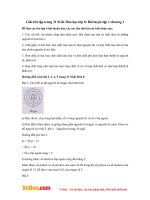bai luyen U 1 - U 3
Bạn đang xem bản rút gọn của tài liệu. Xem và tải ngay bản đầy đủ của tài liệu tại đây (138.09 KB, 16 trang )
Unit 1.A visit from a pen pal
A.Vocabulary
I. Choose A, B, C or D to complete the following sentences:
1. Malaysia is divided ______ two regions.
A. to B. on C. in D. into
2. She often goes to the _____ to pray because her religion is Islam.
A. church B. pagoda C. temple D. mosque
3. Mary was really _____ by the beauty of Hanoi.
A. impress B. impression C. impressive D. impressed
4. The United States has a _____of around 250 million.
A. population B. separation C. addition D. introduction
5. Mathematics and Literature are _____ subjects in high schools.
A. adding B. compulsory C. optional D. religious
6. It’s very kind _____ you to say so!
A. in B. to C. for D. of
7. Can you tell me how many chapters this book consists _____ ?
A. of B. to C. with D.in
8. Don’t forget to add sugar to the mixture. This _____ is important.
A.add B. addition C. additional D. additionally
9. Vietnamese people are very _____ and hospitable.
A. friend B. friendless C. friendly D. friendship
10.They were welcomed by friendly _____ in Viet Nam.
A. air B. matter C. impression D. atmosphere
II. Match each word or phrase in column A to its definition in column B:
A B
1. climate a. an area of land
2. compulsory b. to stop being together, divide
3. territory c. that must be done by law, rules
4. friendliness d. showing kindness and pleasantness
5. separate e. that you can choose or not choose
6. comprise f. the normal weather conditions of a particular region
7. impress g. to consist of
8.optional h. to make somebody feel admiration and respect
III. Supply the correct word form:
1. She was really _____ by the beauty of the city. (impress)
2. She made a deep _____ on the members of her class. (impress)
3. Their_____ made me happy. (friendly)
4. Many _____ come to Ho Chi Minh’s Mausoleum every day. (visit)
5. We enjoyed the _____ atmosphere in Hanoi. (peace)
6. Hanoi is not _____ from Kuala Lumpur. (difference)
7. The girls went to see _____ places in HCMC. (fame)
8. The _____ language in Malaysia is Bahasa Malaysia. (nation)
9. In Malaysia _____ is free. (educate).
10.What is the main language of _____ at that school? (instruct)
IV. Fill in each gap with a suitable preposition:
1. Maryam was really impressed _____ the beauty of Hue.
2. It seems difficult _____ me to meet her now.
3. He does not depend _____ his depend.
4. If you have any trouble, ask _____help.
5. This guidebook is full _____ useful information.
6. We still keep in touch _____ each other although we live away _____ each other.
7. He will go to China _____ the end _____ this week.
8. She went out _____ saying a word.
9. What do you often do _____ the weekends?
10.She was born _____ September 15th.
B. Grammar and structure
I. Choose A, B, C or D to complete the following sentences:
1. I wish Susan _____ harder for her examination.
A. will work B. worked C. has worked D. works
2. What were you doing when he _____?
A.comes B. to come C. came D. coming
3. A good letter needs perfect _____
A. introduce B. introduction C.introducing D. introductory
4. It seems difficult for us _____ abroad at the moment.
A. go B. to go C. went D. gone
5. There used _____ a movie theater here, but it closed a long time ago.
A. be B. to be C. being D. been
6. I come from Vietnam so I am not used to _____ on the left.
A. drive B. drove C. driven D. driving
7. Althought we are fat away from each other, we still _____
A. keep in touch B. say hello C. keep together D. keep on
8. Music and painting are _____
A. option B. optional C. optionally D. optioning
9. The children are playing _____ in the schoolyard.
A. happy B. happily C. happiness D. happiness
10.I wish they _____ here tomorrow.
A. will come B. would come C. come D. came
II. Use “used to” or “be used to”:
1. They are used to/ used to go to Dalat in summer.
2. They are used to/ used to playing soccer in the park.
3. I am used to/ used to getting up early.
4. Tom is used to/ used to do his homework in the evening.
5. Lan is used to/ used to writing to Maryam.
6. He is used to/ used to work at night.
7. Do they used to/ Are they used to watching T.V?
8. Is she used to/Did she used to playing badminton?
9. My father is used to/ used to come home late.
10.She is used to/ used to go swimming in the afternoon.
III. Put the verbs in brackets in the correct form:
1. They used to (go) swimming in the afternoon.
2. He wishes he (be) a doctor.
3. Is Lan used to (write) to Maryam?
4. They (not finish) their work yet.
5. My mother never (eat) the fish before.
6. The Bakers already (tidy) their house.
7. She (work) here since her son (be born)
Unit 2. Clothing
A. Vocabulary
I. Choose A, B, C or D to complete the following sentences
1. … clothes do you prefer. T-shirt or pullover?
A. What B. How C. Which D. Where
2. My uncle was a … He had a large collection of musical instruments.
A. music B. musical C. musically D. musician
3. Vietnamese women prefer to wear modern clothing … work.
A. at B. in C. to D. with
4. Peter got … quickly and went to school.
A. dress B. dressed C.dressing D. dresses
5. It’s … to call anyone at night.
A. convenience B. inconvenience C. convenient D. inconvenient
6. The Ao dai is the … dress of Vietnamese women.
A. beautiful B. traditional C. casual D. baggy
7. … have fashion designers done to modernize the Ao dai
A. How B. What C. Why D. Where
8. The word Jeans comes … a kind of material that was made in Europe
A. in B. at C. from D. on
9. The national dress of Japanese women is …
A. Kimono B. Ao dai C. Sari D. Jeans
10. Nguyen Du is considered a famous Vietnamese …
A. poetry B. poem C. poet D. poetic
II. Complete the sentences with the words in the box
fashionable-especially-cotton-inspiration-unique-wear-designer- generation
1. Poets are normally inspired with beauty. They write a lot of beautiful poems
thanks to this …
2. We attended the fashion show of a leading New York …
3. What will you … at Mary’s birthday party?
4. It’s becoming … to wear short skirts and faded jeans again.
5. These clothes are fashionable and …
6. Vietnamese women usually wear the Ao dai, … on special occasions.
7. In the 18
th
century, jean cloth was made completely from …
8. Young … is fond of wearing Jeans.
III. Underline and rewrite the incorrect words:
1. The Ao dai consists of a long silk tunic that is slit on the sides and worn over lose
pants.
2. Wearing uniforms helps students fall equal in many ways.
3. Paul is a poet. He has written a lot of beautiful poem.
4. She describes herself as a fashion design.
5. They are always pround of their country.
IV. Supply the correct word form
1. Some young people today have a very strange _______ (appear)
2. Her clothes look very modern and __________ (fashion)
3. Many designers took _______ from Vietnam’s ethnic minorities. (inspire)
4. What a _________ T. shirt! (colour)
5. He always wears a __________ shirt. (stripe)
6. She likes to wear ................. Jean cloth. (fade)
7. In the 18
th
century, Jean cloth was made .................... from cotton (complete)
8. I don’t like to wear ........... (paint) and ................... Jeans. (embroider)
9. They have just .................. a new style of Jeans in the USA. (introduction)
10.Some designers have ........ ........ the Ao dai by printing lines of poetry on it
( modern)
B. Grammar and structure
I. Choose A, B, C or D to complete the following sentences:
1. Mary .................. write to me last year.
A. uses to B. used to C. is used to D. was used to
2. She describes herself .............................. a fashion designer.
A. by B. as C, in D. from
3. He .......................... with friends in an apartment in HCM city since last week.
A. living B. has lived C. lived D. live
4. I wish you .............. her tomorrow.
A. come B. came C. will come D. would come
5. I ..................... English here since I graduated from university.
A. teach B. taught C. have taught D. am teaching
6. Wearing uniform helps students .................... equal in many ways.
A. fall B. feel C. fell D. felt
7. it’s dangerous ......................in this river.
A. swim B. to swim C. swimming D. swam
8. Millions of Christmas cards .................. last month.
A. were sent B. sent C. send D. are sent
9. Marie Curie ............... the Noble Prize for Physics in 1903
A. award B. awarded C. was awarded D. has
awarded.
10. He hates being .................................. at.
A. look B. looking C. to look D. looked
II. Supply the correct verb form
1. She often (take) to the theatre by the Greens
2. My car (repair) yesterday.
3. ..... your house (rebuild) next year?
4. Can this car (repair)
5. Must this test (finish) on time?
6. Water can’t (find) here.
7. He used to (take) to school by his mother.
8. ........... English (learn) all over the world?
9. My car (not repair) yet
10.I (invite) to her party last night.
C. Speak
I. Read the dialogue and fill in the gap with suitable sentences
a. the color suits you e. Can I help you?
b. the fitting room is behind here........ f. I’ll take this cream one
c. If you want anything g. Have you got this in a large one?
d. You couldn’t pass me the green colored one h. Yes, it fits perfectly, actually...
Shop assistant : (1)..................................................?
Customer : No, I’m just looking, thanks
Shop assistant : Well,(2).................................just give me a call.
Customer : Err... this jumper (3) ......... ................?
Shop assistant : No, we’ve only got the small and the medium but the sizes
are quite big. Try it on (4) ...................There you are.
Customer : Thanks
Shop assistant : Does it fit OK?
Customer : (5).........................................................
Shop assistant : Yes, it does. It looks really good on you (6)....................................
Customer : Hmm, I don’t know about the color myself. This cream’s going
to be very dirty (7)...............................
Shop assistant : I’m afraid I’ve only got that in the small. The brown one looks
very nice on. We’ve only got that in the medium
Customer : Hmm. No. (8) ....................................................
I like it. How much was it? $ 11.99?
Shop assistant : That one’s .... $ 13.99 actually.
Customer : Oh, well. Can you wrap it up for me?
Shop assistant : Sure. I’ll wrap it up for you.
II. Read the dialogue and answer the following questions:
Tom : Hello, John. Have you been here long ?
John: No, I’ve just arrived
Tom: Did you have a good flight?
John: Yes, It was fine. Thank
Tom: Here, let me take your case.
John: Thank you.
Tom: Have you ever been to London before?
John: No, this is my first visit.
Tom: Well, what would you like to see?
John: I don’t mind. I haven’t thought a bout it.
Tom: Well, let’s go to the Tower of London.
John: That sounds fine.
Tom: OK, well. I’ll pick you up at about three o’clock.
Questions:
1. Has John just arrived there?
2. How was the flight?
3. How long has Tom been in London?
4. Where do they intend to go?
5. When will Tom pick John up?
D. Read
I. Fill in the blanks with proper words, then answer the following questions
Finally- secondary –uniform- firstly -disadvantages- secondly -styles- clothes
In many (1)........ schools in Britain, wearing school (2)............ is compulsory.
Some schools argue that there are many (3) ............ to this system. Most students
don’t agree with school uniform. (4).............. when you have to wear the
same(5)............
as everyone else you don’t have a chance to develop personal taste in the way
you dress . (6) ................... people who look scruffy usually look scruffy in their
uniforms too and you can always tell the people who come from poor homes
because their uniforms are not as new or don’t fit properly. (7)...................,
the main reason why most students don’t like school uniform is because
most schools choose such colors and (8).......... that don’t suit young people at all.
Questions:
1. Do most students agree with school uniform?
………………………………………………………………
2. Does wearing casual clothes make students fell comfortable and self- confident?
……………………………………………………………...
3. What is the main reason that most students don’t like school uniforms?
………………………………………………………………
II. Choose A, B, C or D to complete the following passage
Clothes
Clothes can tell a lot (1).................... a person. Some people like very colorful clothes
because they want everyone (2) ........................... at them and they want to be the
center of things. (3).................. people like to wear nice clothes, but their clothes are not
(4) ..................... of fancy. They do not like people (5)...................................... Clothes
today are very different (6) ................. the clothes of the 1800s. One difference is the
way the look. For example, in the 1800s, all women (7)........................ dress . The dress
all had long skirts, But today, women do not always wear dresses with long skirts.
Sometimes they wear short skirts. Sometimes they wear pants. Another difference
between 1800 and today is to (8) ............... In the 1800s, clothes (9) ........................
natural kinds of cloth. They were made from cotton, wool, silk or linen. But today there
are (10)................. kinds of man cloth. A lot of clothes are now made from nylon, rayon
or polyester.
1. A. about B. at C. with D. on
2. A. look B. to look C. other D. other
3. A. each other B. another C. others D. other
4. A. color B. colorfully C. colorfull D. colored
5. A. to look at them B. to looking at them C. looking at them D. looked at them
6. A. at B. to C. from D. in
7. A. wear B. worn C. wore D. wearing
8. A. cloth B. clothing C. clothe D. clothes
9. A. were made only by B. were made only of C. were made only in D.were made only
from
10. A. many B. much C. any D. a little
III. Read this announcement carefully, then answer the following questions:
Attention, please. Here is a special announcement. A little girl is reported missing.
She was last seen 20 minutes ago near the main entrance to the car Fair. Her name’s
Mary and she is 3 years old. She was dark,short hair. She is wearing shorts, the blue
shorts and a long-sleeved blouse. She is wearing a pair of shoes, the brown shoes. She
may be carrying a large doll.
If you see Mary, please bring her to the Information Desk. Her father is waiting for
her there. Thanks.
Questions:
1. How old is Mary?
.....................................................................................................
2. Where does she lose her way?
......................................................................................................
3. What is she wearing?
......................................................................................................
4. Where is Mary’s father waiting for her?
......................................................................................................
E. Write
I. Rewrite the following sentences so that the second sentence means
nearly exactly the same as the first one:
1. We have learnt English for 4 years.
We started ....................................................................
2. My father started to give up smoking last year.
My father has .................................................................
3. They have worked in that factory since 2001.
They started ..................................................................
4. Lan hasn’t written to Maryam for a month.
Lan didn’t .....................................................................
5. He has lived in Hanoi since he was 12.
He started ....................................................................
6. I haven’t seen her for a long time.
I didn’t .........................................................................
7. How long have you learnt French?
How long ago ...............................................................
8. When did you start to listen to classical music?
How long .......................................................?
9. I last saw her 10 years ago.
I haven’t ..........................................................
10. How long have you bought this car?
When did .........................................................
II. Turn into Passive
1. He finished his exercises on time.
.................................................................................
2. People plant rice in those fields.
.................................................................................
3. They use cars and trucks to carry food to market.
.................................................................................
4. This boy broke my windows yesterday.
.................................................................................
5. They have known him well.
.................................................................................
6.We will meet him at the station.
.................................................................................
7. Did you do your test perfectly?
.................................................................................
1. Why didn’t you learn this lesson?
.................................................................................
9. How long have they done their work?









